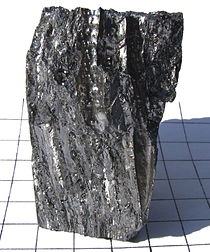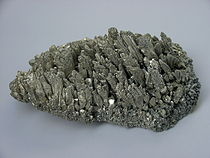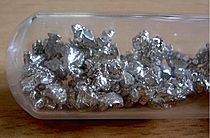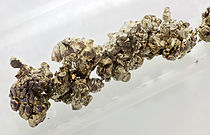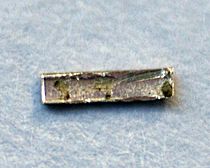
Alkaline earth metal
About this schools Wikipedia selection
SOS believes education gives a better chance in life to children in the developing world too. SOS Children has looked after children in Africa for forty years. Can you help their work in Africa?
| Alkaline earth metals | |||||||||||||||||||||||||||||||||||||||||||||||||||||||||||||||||||||||||||||||||||||||||||||||||||||||||||||||||||||||||||||||||||||||||||||||||||||||||||||||||||||||||||||||||||||||||||||||||||||||||||||||||||||||||||||||||
|---|---|---|---|---|---|---|---|---|---|---|---|---|---|---|---|---|---|---|---|---|---|---|---|---|---|---|---|---|---|---|---|---|---|---|---|---|---|---|---|---|---|---|---|---|---|---|---|---|---|---|---|---|---|---|---|---|---|---|---|---|---|---|---|---|---|---|---|---|---|---|---|---|---|---|---|---|---|---|---|---|---|---|---|---|---|---|---|---|---|---|---|---|---|---|---|---|---|---|---|---|---|---|---|---|---|---|---|---|---|---|---|---|---|---|---|---|---|---|---|---|---|---|---|---|---|---|---|---|---|---|---|---|---|---|---|---|---|---|---|---|---|---|---|---|---|---|---|---|---|---|---|---|---|---|---|---|---|---|---|---|---|---|---|---|---|---|---|---|---|---|---|---|---|---|---|---|---|---|---|---|---|---|---|---|---|---|---|---|---|---|---|---|---|---|---|---|---|---|---|---|---|---|---|---|---|---|---|---|---|---|---|---|---|---|---|---|---|---|---|---|---|---|---|---|---|
|
alkali metals ← → group 3
|
|||||||||||||||||||||||||||||||||||||||||||||||||||||||||||||||||||||||||||||||||||||||||||||||||||||||||||||||||||||||||||||||||||||||||||||||||||||||||||||||||||||||||||||||||||||||||||||||||||||||||||||||||||||||||||||||||
|
|||||||||||||||||||||||||||||||||||||||||||||||||||||||||||||||||||||||||||||||||||||||||||||||||||||||||||||||||||||||||||||||||||||||||||||||||||||||||||||||||||||||||||||||||||||||||||||||||||||||||||||||||||||||||||||||||
| ↓ Period | |||||||||||||||||||||||||||||||||||||||||||||||||||||||||||||||||||||||||||||||||||||||||||||||||||||||||||||||||||||||||||||||||||||||||||||||||||||||||||||||||||||||||||||||||||||||||||||||||||||||||||||||||||||||||||||||||
| 2 |
Beryllium (Be) 4 |
||||||||||||||||||||||||||||||||||||||||||||||||||||||||||||||||||||||||||||||||||||||||||||||||||||||||||||||||||||||||||||||||||||||||||||||||||||||||||||||||||||||||||||||||||||||||||||||||||||||||||||||||||||||||||||||||
| 3 |
Magnesium (Mg) 12 |
||||||||||||||||||||||||||||||||||||||||||||||||||||||||||||||||||||||||||||||||||||||||||||||||||||||||||||||||||||||||||||||||||||||||||||||||||||||||||||||||||||||||||||||||||||||||||||||||||||||||||||||||||||||||||||||||
| 4 |
Calcium (Ca) 20 |
||||||||||||||||||||||||||||||||||||||||||||||||||||||||||||||||||||||||||||||||||||||||||||||||||||||||||||||||||||||||||||||||||||||||||||||||||||||||||||||||||||||||||||||||||||||||||||||||||||||||||||||||||||||||||||||||
| 5 |
Strontium (Sr) 38 |
||||||||||||||||||||||||||||||||||||||||||||||||||||||||||||||||||||||||||||||||||||||||||||||||||||||||||||||||||||||||||||||||||||||||||||||||||||||||||||||||||||||||||||||||||||||||||||||||||||||||||||||||||||||||||||||||
| 6 |
Barium (Ba) 56 |
||||||||||||||||||||||||||||||||||||||||||||||||||||||||||||||||||||||||||||||||||||||||||||||||||||||||||||||||||||||||||||||||||||||||||||||||||||||||||||||||||||||||||||||||||||||||||||||||||||||||||||||||||||||||||||||||
| 7 |
Radium (Ra) 88 |
||||||||||||||||||||||||||||||||||||||||||||||||||||||||||||||||||||||||||||||||||||||||||||||||||||||||||||||||||||||||||||||||||||||||||||||||||||||||||||||||||||||||||||||||||||||||||||||||||||||||||||||||||||||||||||||||
|
Legend
|
|||||||||||||||||||||||||||||||||||||||||||||||||||||||||||||||||||||||||||||||||||||||||||||||||||||||||||||||||||||||||||||||||||||||||||||||||||||||||||||||||||||||||||||||||||||||||||||||||||||||||||||||||||||||||||||||||
The alkaline earth metals are a group of chemical elements in the periodic table with very similar properties. They are all shiny, silvery-white, somewhat reactive metals at standard temperature and pressure and readily lose their two outermost electrons to form cations with charge +2. In the modern IUPAC nomenclature, the alkaline earth metals comprise the group 2 elements.
The alkaline earth metals are beryllium (Be), magnesium (Mg), calcium (Ca), strontium (Sr), barium (Ba), and radium (Ra). This group lies in the s-block of the periodic table as all alkaline earth metals have their outermost electron in an s-orbital.
All the discovered alkaline earth metals occur in nature. Experiments have been conducted to attempt the synthesis of element 120, which is likely to be the next member of the group, but they have all met with failure. However, element 120 may not be an alkaline earth metal due to relativistic effects, which are predicted to have a large influence on the chemical properties of superheavy elements.
Characteristics
Chemical
Like other groups, the members of this family show patterns in its electronic configuration, especially the outermost shells, resulting in trends in chemical behaviour:
| Z | Element | No. of electrons/shell | Electron configuration |
|---|---|---|---|
| 4 | beryllium | 2, 2 | [He] 2s2 |
| 12 | magnesium | 2, 8, 2 | [Ne] 3s2 |
| 20 | calcium | 2, 8, 8, 2 | [Ar] 4s2 |
| 38 | strontium | 2, 8, 18, 8, 2 | [Kr] 5s2 |
| 56 | barium | 2, 8, 18, 18, 8, 2 | [Xe] 6s2 |
| 88 | radium | 2, 8, 18, 32, 18, 8, 2 | [Rn] 7s2 |
Most of the chemistry has been observed only for the first five members of the group. The chemistry of radium is not well established due to its radioactivity; thus, the presentation of its properties here is limited.
The alkaline earth metals are all silver-colored, soft, and have relatively low densities, melting points, and boiling points. In chemical terms, all of the alkaline metals react with the halogens to form the alkaline earth metal halides, all of which are ionic crystalline compounds (except for beryllium chloride, which is covalent). All the alkaline earth metals except beryllium also react with water to form strongly alkaline hydroxides and thus should be handled with great care. The heavier alkaline earth metals react more vigorously than the lighter ones. The alkaline metals have the second-lowest first ionization energies in their respective periods of the periodic table because of their somewhat low effective nuclear charges and the ability to attain a full outer shell configuration by losing just two electrons. The second ionization energy of all of the alkaline metals is also somewhat low.
Beryllium is an exception: It does not react with water or steam, and its halides are covalent. If beryllium did form compounds with an ionization state of +2, it would polarize electron clouds that are near it very strongly and would cause extensive orbital overlap, since beryllium has a high charge density. All compounds that include beryllium have a covalent bond. Even the compound beryllium fluoride, which is the most ionic beryllium compound, has a low melting point and a low electrical conductivity when melted.
All the alkaline earth metals have two electrons in their valence shell, so the energetically preferred state of achieving a filled electron shell is to lose two electrons to form doubly charged positive ions.
Compounds and reactions
The alkaline earth metals all react with the halogens to form ionic halides, such as calcium chloride (CaCl2), as well as reacting with oxygen to form oxides such as strontium oxide (SrO). Calcium, strontium, and barium react with water to produce hydrogen gas and their respective hydroxides, and also undergo transmetalation reactions to exchange ligands.
-
Alkaline earth metals fluorides solubility-related constants Metal
M2+
HE
F-
HE
"MF2"
unit
HEMF2
lattice
energies
Solubility
Be 2,455 458 3,371 3,526 soluble Mg 1,922 458 2,838 2,978 0.0012 Ca 1,577 458 2,493 2,651 0.0002 Sr 1,415 458 2,331 2,513 0.0008 Ba 1,361 458 2,277 2,373 0.006
Physical and atomic
The table below is a summary of the key physical and atomic properties of the alkaline earth metals.
| Alkaline earth metal | Standard atomic weight ( u) |
Melting point (K) |
Melting point (°C) |
Boiling point (K) |
Boiling point (°C) |
Density (g/cm3) |
Electronegativity ( Pauling) |
First ionization energy ( kJ·mol−1) |
Covalent radius ( pm) |
Flame test colour | |
|---|---|---|---|---|---|---|---|---|---|---|---|
| Beryllium | 9.012182(3) | 1560 | 1287 | 2742 | 2469 | 1.85 | 1.57 | 899.5 | 105 | White | |
| Magnesium | 24.3050(6) | 923 | 650 | 1363 | 1090 | 1.738 | 1.31 | 737.7 | 150 | Brilliant white | |
| Calcium | 40.078(4) | 1115 | 842 | 1757 | 1484 | 1.54 | 1.00 | 589.8 | 180 | Brick-red | |
| Strontium | 87.62(1) | 1050 | 777 | 1655 | 1382 | 2.64 | 0.95 | 549.5 | 200 | Crimson | |
| Barium | 137.327(7) | 1000 | 727 | 2170 | 1897 | 3.594 | 0.89 | 502.9 | 215 | Apple green | |
| Radium | [226] | 973 | 700 | 2010 | 1737 | 5.5 | 0.9 | 509.3 | 221 | Crimson red | |
Nuclear stability
All of the alkaline earth metals except magnesium and strontium have at least one naturally occurring radioisotope: beryllium-7, beryllium-10, and calcium-41 are trace radioisotopes, calcium-48 and barium-130 have very long half-lives and thus occur naturally, and all isotopes of radium are radioactive. Calcium-48 is the lightest nuclide to undergo double beta decay.
The natural radioisotope of calcium, calcium-48, makes up about 0.1874% of natural calcium, and thus natural calcium is weakly radioactive. Barium-130 makes up approximately 0.1062% of natural barium, and thus barium is weakly radioactive as well.
History
Etymology
The alkaline earth metals are named after their oxides, the alkaline earths, whose old-fashioned names were beryllia, magnesia, lime, strontia and baryta. These oxides are basic (alkaline) when combined with water. "Earth" is an old term applied by early chemists to nonmetallic substances that are insoluble in water and resistant to heating—properties shared by these oxides. The realization that these earths were not elements but compounds is attributed to the chemist Antoine Lavoisier. In his Traité Élémentaire de Chimie (Elements of Chemistry) of 1789 he called them salt-forming earth elements. Later, he suggested that the alkaline earths might be metal oxides, but admitted that this was mere conjecture. In 1808, acting on Lavoisier's idea, Humphry Davy became the first to obtain samples of the metals by electrolysis of their molten earths, thus supporting Lavoisier's hypothesis and causing the group to be named the alkaline earth metals.
Discovery
The calcium compounds calcite and lime have been known and used since prehistoric times. The same is true for the beryllium compounds beryl and emerald. The other compounds of the alkaline earth metals were discovered starting in the early 15th century. The magnesium compound magnesium sulfate was first discovered in 1618 by farmer at Epsom in England. Strontium carbonate was discovered in minerals in the Scottish village of Strontian in 1790. The last element was the least abundant radioactive radium which was extracted from uraninite in 1898.
All elements except beryllium were isolated by electrolysis of molten compounds. Magnesium, calcium and strontium were first produced by Humphry Davy in 1808, while beryllium was independently isolated Friedrich Wöhler and Antoine Bussy in 1828 by reacting berylium compounds with potassium. In 1910, radium was isolated as a pure metal by Curie and André-Louis Debierne also by electrolysis.
Beryllium
Beryl, a mineral which contains beryllium, has been known since the time of the Ptolemaic dynasty in Egypt. Although it was originally thought that beryl was an aluminium silicate, beryl was later found to contain a then-unknown element when, in 1797, Louis-Nicolas Vauquelin dissolved aluminium hydroxide from beryl in an alkali. In 1828, Friedrich Wöhler and Antoine Bussy independently isolated this new element, beryllium, by the same method, which involved a reaction of beryllium chloride with metallic potassium; this reaction was not able to produce large ingots of beryllium. It was not until 1898, when Paul Lebeau performed an electrolysis of a mixture of beryllium fluoride and sodium fluoride that large pure samples of beryllium were produced.
Magnesium
Magnesium was first produced by Sir Humphry Davy in England in 1808 using electrolysis of a mixture of magnesia and mercuric oxide. Antoine Bussy prepared it in coherent form in 1831. Davy’s first suggestion for a name was magnium, but the name magnesium is now used.
Calcium
Lime has been used as a material for building since 7000 to 14,000 BCE, and kilns used for lime have been dated to 2,500 BCE in Khafaja, Mesopotamia. Calcium as a material has been known since at least the first century, as the ancient Romans were known to have used calcium oxide by preparing it from lime. Calcium sulfate has been known to be able to set broken bones since the tenth century. Calcium itself, however, was not isolated until 1808, when Humphry Davy, in England, used electrolysis on a mixture of lime and mercuric oxide, after hearing that Jöns Jakob Berzelius had prepared a calcium amalgam from the electrolysis of lime in mercury.
Strontium
In 1790, physician Adair Crawford, who had been working with barium, realized that Strontian ores showed different properties than other supposed ores of barium. Therefore, he concluded that these ores contained new minerals, which were named strontites in 1793 by Thomas Charles Hope, a chemistry professor at the University of Glasgow, who confirmed Crawford's discovery. Strontium was eventually isolated in 1808 by Sir Humphry Davy by electrolysis of a mixture of strontium chloride and mercuric oxide. The discovery was announced by Davy on 30 June 1808 at a lecture to the Royal Society.
Barium
Barite, a mineral containing barium, was first recognized as containing a new element in 1774 by Carl Scheele, although he was only able to isolate barium oxide. Barium oxide was isolated again two years later by Johan Gottlieb Gahn. Later in the 18th century, William Withering noticed a heavy mineral in the Cumberland lead mines, which is now known to contain barium. Barium itself was finally isolated in 1808 when Sir Humphry Davy used electrolysis with molten salts, and Davy named the element barium, after baryta. Later, Robert Bunsen and Augustus Matthiessen isolated pure barium by electrolysis of a mixture of barium chloride and ammonium chloride.
Radium
While studying uraninite, on 21 December 1898, Marie and Pierre Curie discovered that even after uranium had decayed, the material created was still radioactive. The material behaved somewhat similarly to barium compounds, although some properties, such as the colour of the flame test and spectral lines, were much different. They announced the discovery of a new element on 26 December 1898 to the French Academy of Sciences. Radium was named in 1899 from the word radius, meaning ray, as radium emitted power in the form of rays.
Occurrence
Beryllium occurs in the earth's crust at a concentration of two to six parts per million (ppm), much of which is in soils, where it has a concentration of six ppm. Beryllium is one of the rarest elements in seawater, even rarer than elements such as scandium, with a concentration of 0.2 parts per trillion. However, in freshwater, beryllium is somewhat more common, with a concentration of 0.1 parts per billion.
Magnesium and calcium are both incredibly abundant in the earth's crust, with calcium being the fifth most abundant element, and magnesium the eighth. While none of the alkaline earth metals are ever found in their elemental state, magnesium and calcium are found in many rocks and minerals. Magnesium is often found in carnellite, magnesite, and dolomite, while calcium is often found in chalk, limestone, gypsum, and anhydrite.
Strontium is also incredibly common on earth, being the fifteenth most abundant element in the crust. Most strontium in the crust is in the minerals celestite and strontianite. Barium is slightly less common, and much of it is in the mineral barite.
Radium, being a decay product of uranium, is found in all uranium-bearing ores. Due to its relatively short half-life, no radium that was present when the earth was formed is still around today, and instead has all come from the gradual decay of the uranium.
Production
Most beryllium is extracted from beryllium hydroxide. One way to create this substance is a sintering method, which is done by mixing beryl, sodium fluorosilicate, and soda at high temperatures, which forms sodium fluoroberyllate, aluminium oxide and silicon dioxide. An solution of sodium fluoroberyllate and sodium hydroxide in water is then used to form beryllium hydroxide by precipitation. Another method used is known as the melt method. In it, beryl is heated to high temperatures while in a powdered form, and is then cooled with water. It is then heated again slightly while in sulfuric acid, eventually yielding beryllium hydroxide. The created beryllium hydroxide from either method is then used to create beryllium fluoride and beryllium chloride through a somewhat long process. Electrolysis or heating of these compounds can then be used to obtain beryllium.
Strontium carbonate is generally extracted from the mineral celestite. This can be done through two methods: either leaching the celestite with sodium carbonate, or by a more complicated method involving coal.
Barium can be produced from barite ore. Once the ore has been mined, it has to be separated from quartz, sometimes by froth flotation methods, resulting in relatively pure barite. Carbon is then used to reduce the baryte into barium sulfide. The barium sulfide can then be dissolved with other elements to form other compounds, such as barium nitrate, which in turn can be thermally decompressed into barium oxide, which eventually can yield pure barium after a reaction with aluminium. The most important supplier of barium is China, which produces more than 50% of the world's barium.
Applications
Beryllium is mostly used for military applications, but there are other uses of beryllium as well. In electronics, beryllium is used as a p-type dopant in some semiconductors, and beryllium oxide is used as a high-strength electrical insulator and heat conductor. Due to its light weight and other properties, beryllium is also used in mechanics when stiffness, light weight, and dimensional stability are required at wide temperature ranges.
Magnesium has many different uses. One of its most common uses was in industry, where it has many structural advantages over other materials such as aluminium, although this usage has fallen out of favour recently due to magnesium's flammability. Magnesium is also often alloyed with aluminium or zinc to form materials with more desirable properties than any pure metal. Magnesium has many other uses in industrial applications, such as having a role in the production of iron and steel, and the production of titanium.
Calcium also has many uses. One of its uses is as a reducing agent in the separation of other metals form ore, such as uranium. It is also used in the production of the alloys of many metals, such as aluminium and copper alloys, and is also used to deoxidize alloys as well. Calcium also has a role in the making of cheese, mortars, and cement.
Strontium and barium do not have as many applications as the lighter alkaline earth metals, but still have uses. Strontium carbonate is often used in the manufacturing of red fireworks, and pure strontium is used in the study of neurotransmitter release in neurons. Barium has some use in vacuum tubes to remove gases, and barium sulfate has many uses in the petroleum industry, as well as other industries.
Due to its radioactivity, radium no longer has many applications, but it used to have many. Radium used to be used often in luminous paints, although this use was stopped after workers got sick. As people used to think that radioactivity was a good thing, radium used to be added to drinking water, toothpaste, and many other products, although they are also not used anymore due to their health effects. Radium is no longer even used for its radioactive properties, as there are more powerful and safer emitters than radium.
Biological role and precautions
Magnesium and calcium are ubiquitous and essential to all known living organisms. They are involved in more than one role, with, for example, magnesium or calcium ion pumps playing a role in some cellular processes, magnesium functioning as the active centre in some enzymes, and calcium salts taking a structural role, most notably in bones.
Strontium plays an important role in marine aquatic life, especially hard corals, which use strontium to build their exoskeletons. It and barium have some uses in medicine, for example " barium meals" in radiographic imaging, whilst strontium compounds are employed in some toothpastes. Excessive amounts of strontium-90 are toxic due to its radioactivity.
Beryllium and radium, however, are toxic. Beryllium's low aqueous solubility means it is rarely available to biological systems; it has no known role in living organisms, and when encountered by them, is usually highly toxic. Radium has a low availability and is highly radioactive, making it toxic to life.
Extensions
The next alkaline earth metal after radium is thought to be element 120, although this may not be true due to relativistic effects. The synthesis of element 120 as first attempted in March 2007, when a team at the Flerov Laboratory of Nuclear Reactions in Dubna bombarded plutonium-244 with iron-58 ions; however, no atoms were produced, leading to a limit of 400 fb for the cross-section at the energy studied. In April 2007, a team at the GSI attempted to create element 120 by bombarding uranium-238 with nickel-64, although no atoms were detected, leading to a limit of 1.6 pb for the reaction. Synthesis was again attempted at higher sensitivities, although no atoms were detected. Other reactions have been tried, although all have been met with failure.
The chemistry of element 120 is predicted to be closer to that of calcium or strontium instead of barium or radium. This is unusual as periodic trends would predict element 120 to be more reactive than barium and radium. This lowered reactivity is due to the expected energies of element 120's valence electrons, increasing element 120's ionization energy and decreasing the metallic and ionic radii.

